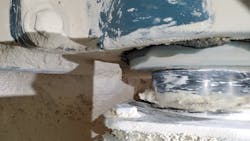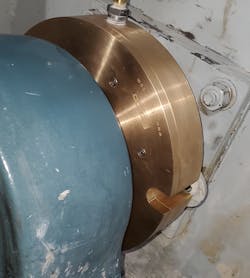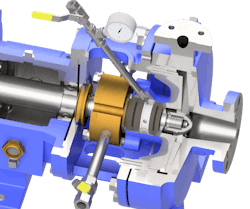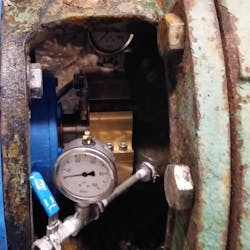Blocking powder leakage from rotating-shaft equipment
Powders and slurries can be tough on equipment. They are gritty and abrasive. The shafts of pumps, mixers, blenders and agitators experience wear as they move through the material. In addition to this wear, shaft deflection occurs as ingredients are added to the bowls of the equipment. In a paper mill, for example, tons of recycled paper can be dropped from above into the mill’s agitator.
Compression packing and mechanical seals can be effective in many applications, but for powders and slurries (especially if deflection occurs), they may not withstand the abuse. Deflection bends and deforms compression packing and damages mechanical seals.
Wear and deflection further open clearances and leakage paths in seal technology. A larger leak path allows for more powder or slurry to leak.
Process leakage causes a host of problems, including:
- Wasted product
- Housekeeping issues, with product leaking onto floors
- Slip/fall hazards
- Bacterial buildup and other sanitation risks
- Contamination of nearby equipment
- Lost production time for maintenance, repairs, and replacements when equipment fails
Identifying the weak spot
Many factors affect why process material leaks from rotating equipment. Changing the seal technology may not be the solution to every leakage problem. However, updating to a technology that helps minimize or eliminate some of the factors that make powders and slurries so tough to seal is often a good first step. The following case studies demonstrate how replacing traditional technology with an air seal or an air seal system eliminates many of the problems caused when powders and slurries damage some sealing technology.
Case study 1: Drywall producer screw conveyor
A drywall facility had a problem with gypsum leaking out of a screw conveyor. Gypsum is a soft mineral used in drywall and other materials, such as fertilizer, plaster and chalk. It causes a mess in facilities that process it. The drywall producer team sought a new solution to eliminate the mess.
The drywall facility’s screw conveyor used compression packing rings to seal the conveyor’s shaft. Compression packing can be effective in many applications but can easily become contaminated when sealing equipment handling dry powders. This causes packing wear, excess material leakage, and shaft wear. The leaking gypsum created a major housekeeping issue for the plant, as shown in Photo 1. The leaking also cost money due to:
- Wasted product.
- Compression packing replacements, which were needed every couple months. (The facility did not always have the personnel to perform the replacements)
- Repeated bearing failures due to gypsum contaminating the lubricant.
The team decided to try an SAS air seal. An air seal is a noncontact technology that uses engineered clearances and directional flow paths to create uniform pressure and velocity profiles, generating a pneumatic seal.
To accommodate misalignment that may be present in many rotating applications, a floating throttle inside the seal handles ±0.125 inch of parallel movement. This movement withstands any shaft deflection that may occur. By controlling the internal pressure or flow profile, the seal forms a boundary layer of air between the throttle and the shaft/sleeve. This boundary mitigates any damage that would occur from mechanical runout because the throttle floats on the boundary layer and never touches the shaft.
In March 2020, the drywall producer installed the air seal on the screw conveyor (Photo 2). In the two years since the installation, the seal has experienced zero leakage. This is an improvement of a mean time between replacement from every two months to more than 22 months.
The air seal eliminated the screw conveyor’s problems. The plant saved money; decreased personnel time on maintenance, housekeeping and packing replacements; reduced bearing failures; and eliminated product waste.
Case study 2: Paper mill hydrapulper discharge pump
Centrifugal pumps that move slurries endure abuse from entrained particulates and other solids. A mill in South-central North Carolina produces packaging and tissue products. The facility had a hydrapulper discharge pump that had repeatedly failed.
The hydrapulper discharge pump’s single-cassette mechanical seal only lasted a week or two. Its wet end was not bolted down. Instead, it was slotted with a concrete pad. This configuration resulted in too much pipe strain, causing the mechanical seal to fail.
The team replaced the failing seal with an air seal system specifically designed for centrifugal pumps (Photo 3). This system included a noncontact tandem seal that uses air to seal and water to flush/clean the stuffing box. This setup minimized or eliminated damage to the seal components from particulates. The system incorporates:
- Two shaft-supporting bushings
- An air seal
- A lantern ring
The system’s configuration prevents the slurry material from reaching the seal and causing damage. Because the air seal is noncontact and floats above the shaft, the system is impervious to system conditions that damage or destroy traditional seals and pumps, such as:
- Pipe strain
- Misalignment
- Off-BEP operation
- Cavitation
With this new system, the plant team throttled back the flush system (introduced through the lantern ring), operating at 15 psi higher than stuffing box pressure. The plant air on the air seal was set at 5 to 10 psi higher than the flush pressure. The system on the centrifugal pump (Photo 4) has successfully operated for more than a year. The maintenance supervisor for the mill plans to expand the system’s use to other pumps in the facility.
“The SAS-P system increased our pump uptime significantly,” said a maintenance supervisor for the paper mill. “The pump had been failing about every other week. Since the SAS-P installation more than 11 months ago, we have had zero failures.”
Zach Nepa ([email protected]) is a regional manager for Sealing Equipment Products Company (SEPCO). He has more than five years in the sealing industry and graduated with a B.A. from the State University of New York at Binghamton.
David Brewer ([email protected]) is regional manager, Atlantic Region, for SEPCO. Before this role, he served four years in the U.S. Navy and received three Letters of Commendation. He began his career in the fluid sealing industry and worked with many manufacturers before joining SEPCO team.
Terry Roberts ([email protected]) is the Midwest regional manager for SEPCO. He has worked in the fluid sealing industry for 23 years and provides training, sales support and solutions to channel partners and their customers.
Editor's note: This article is based on a session presented during the 2021 International Powder & Bulk Solids Conference & Exhibition.
SEPCO



